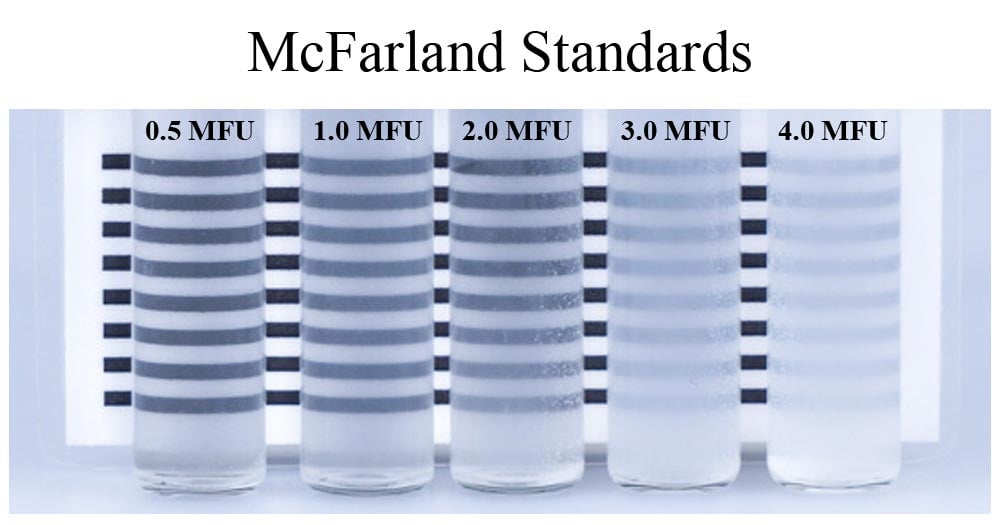Interesting Science Videos
What is McFarland Standards?
McFarland Standards are used as the reference in order to adjust the turbidity of the liquid/ bacterial suspension in the vial or tube in the microbiology laboratory. It helps to maintain and/or ensure that the number of bacteria will be within a given range to standardize microbial testing. The McFarland standard can be prepared of the varying concentration ranging from the 0.5 to 4 concentration and depending upon the concentration, the cell count density varies. However, the most commonly used concentration for the antimicrobial susceptibility testing and the culture media performance testing is usually done by 0.5 McFarland standard in the microbiological laboratories.
Principle of McFarland Standards
A McFarland Standard is a chemical solution of barium chloride and sulfuric acid. The chemical reaction between these two chemicals results in the production of a fine precipitate of barium sulfate. After shaking well, the turbidity of a McFarland Standard is visually comparable to a bacterial suspension of known concentration. McFarland turbidity standards are prepared by mixing various volumes of 1% sulfuric acid and 1% barium chloride to obtain solutions with specific optical densities. By adjusting the volume of these two chemical reagents, McFarland standards of varying degrees of turbidity can be prepared which represent different bacterial density or cell count. 0.5 McFarland turbidity standard provides an optical density comparable to the density of a bacterial suspension with a 1.5 x 10^8 colony forming units (CFU/ml).

Image Source: Bioanalytic GmbH
| McFarland Standard | 1% BaCl2(ml) | 1% H2SO4 (ml) | Approximate Cell Count Density (x10^8 cells) |
| 0.5 | 0.05 | 9.95 | 1.5 x 10^8 |
| 1.0 | 0.1 | 9.9 | 3.0 x 10^8 |
| 2.0 | 0.2 | 9.8 | 6.0 x 10^8 |
| 3.0 | 0.3 | 9.7 | 9.0 x 10^8 |
| 4.0 | 0.4 | 9.6 | 12.0 x 10^8 |
Preparation of McFarland Standards
- Prepare a 1% solution of anhydrous barium chloride (BaCl2) and 1% solution of sulfuric acid (H2SO4)
- Combine and completely mix the barium chloride and sulfuric acid solutions to form a turbid suspension.
- Place the resulting mixture in a foil-covered screw-cap tube.
- Store the McFarland standard at room temperature (25 °C) when not in use. McFarland standard density solution will precipitate and clump over time, and it needs vigorous agitation (vortexing) or shaking before each use. Note: Mark the tube to indicate the level of liquid, and check before use to be sure that evaporation has not occurred.
- In the presence of good lighting, visually compare the turbidity by holding the bacterial sample and McFarland Standard tubes up against the black and white bars printed on the enclosed card.
- In case of heavy turbidity, adjust the turbidity of the log growth of the bacterial suspension with the addition of broth or saline via sterile pipette to match the turbidity to that of a known McFarland Equivalence Standard.
- If the test suspension is too light, inoculate with additional organisms or incubate tubes until turbidity matches that of the standard.
Uses of McFarland Standards
- It is used in the antimicrobial susceptibility testing procedure where the bacterial suspension is compared to Standard Mcfarland, prior to swab on MHA media.
- It is a part of quality control to check and adjust the densities of bacterial suspension that can be used for identification and susceptibility procedure.
Limitations of McFarland Standards
- In the case of the colored media, it may not provide proper contrast with McFarland Equivalence Standards with the occurrence of incorrect results or incorrect densities.
- The older cultures (>24 hours)of bacterial suspensions may not compare to expected bacterial counts.
- The Mcfarland standards have been adjusted by a spectrophotometer analysis. The use of any other instrumentation may not give reliable results during the testing procedure.
- While using the latex standard, the tubes for the suspension should be the same diameter as the McFarland Latex Standard tube.
- During the storage time, exposure of the McFarland standard to the light can affect the turbidity measurement.
References
- McFarland J (1907). Nephelometer: an instrument for media used for estimating the number of bacteria in suspensions used for calculating the opsonic index and for vaccines. J Am Med Assoc 14:1176-1178.
- Dalynn Biologicals (http://www.dalynn.com/dyn/ck_assets/files/tech/TM53.pdf)
- Himedia (http://himedialabs.com/TD/R092.pdf)
- Pro-Lab Diagnostics (https://www.pro-lab.com/wp-content/uploads/2017/01/SD2300-SD2350_en.pdf)
- Becton, Dickinson, and Company (https://legacy.bd.com/europe/regulatory/Assets/IFU/US/8808421(0205)_en.pdf)

if we make the serial dilutions of 0.5 MCF standard ‘then 100 cfu per ml should be in the tube with dilution factor 10^6 .but when we calculate by using formula 100 cfu per ml are obtained in the tube with dilution factor 10^5.
CFU per ml=no of colonies X DF / Volume plated
Kindly solve it.
Hi Dear; Ineed journal name and page for this reference ARYAL, S. 2021. McFarland Standards-Principle, Preparation, Uses, Limitations. Microbe Notes.
Biomerieux recommends different Mac Farland concentration based on organism type considering E.coli suspension is more denser that Ps. aeruginosa
One of my professor asked me a question on this. Ma’am Can I please get the related article or study about it since I am not able to find it.
Thank you
It’s good but you can add the absorbance of the MacFarland standards to the table.
It is good.also add another documents.